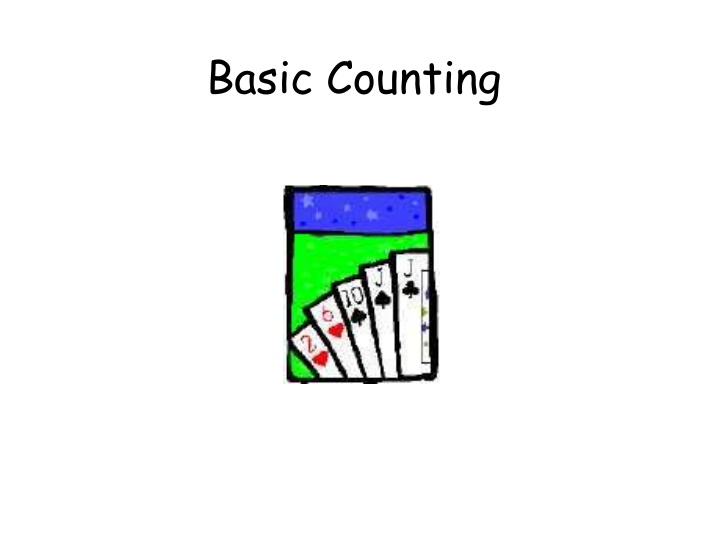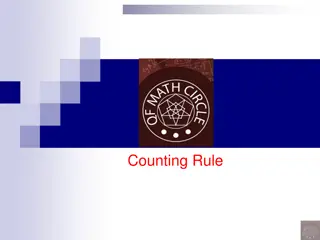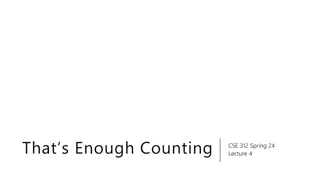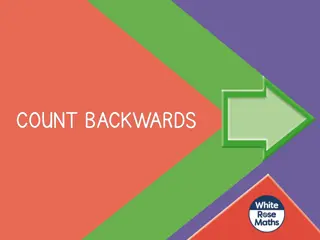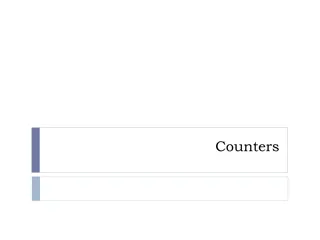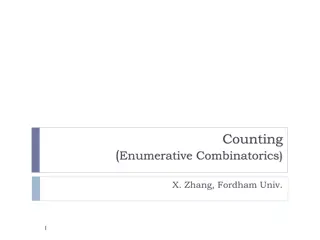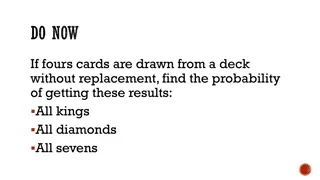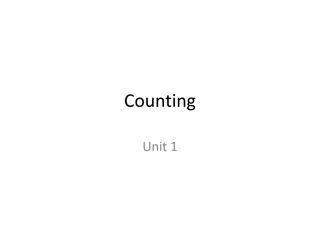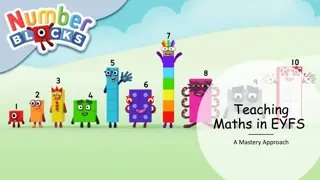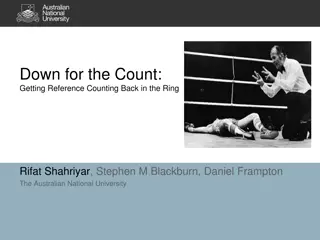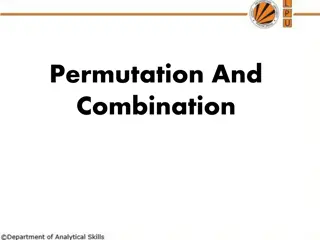Fundamentals of Counting Principles in Mathematics
In this lecture, we delve into basic rules for counting, including the sum rule, product rule, generalized product rule, permutations, combinations, binomial coefficients, and combinatorial proofs. We also explore the inclusion-exclusion principle with practical examples such as determining total enrollments in a class and the number of possible married couples. Additionally, we illustrate the application of these principles in counting strings and IP addresses. These foundational concepts provide a comprehensive understanding of counting methodologies in mathematics.
Download Presentation

Please find below an Image/Link to download the presentation.
The content on the website is provided AS IS for your information and personal use only. It may not be sold, licensed, or shared on other websites without obtaining consent from the author.If you encounter any issues during the download, it is possible that the publisher has removed the file from their server.
You are allowed to download the files provided on this website for personal or commercial use, subject to the condition that they are used lawfully. All files are the property of their respective owners.
The content on the website is provided AS IS for your information and personal use only. It may not be sold, licensed, or shared on other websites without obtaining consent from the author.
E N D
Presentation Transcript
This Lecture We will study some basic rules for counting. Sum rule, product rule, generalized product rule Permutations, combinations Binomial coefficients, combinatorial proof Inclusion-exclusion principle
Sum Rule |S|: the number of elements in a set S. B A If sets A and B are disjoint, then |A B| = |A| + |B|
Sum Rule B A If sets A and B are disjoint, then |A B| = |A| + |B| Class has 43 women, 54 men, so total enrollment = 43 + 54 = 97 26 lower case letters, 26 upper case letters, and 10 digits, so total characters = 26+26+10 = 62
Product Rule Recall that, given two sets A and B, the Cartisean product Fact: If |A| = n and |B| = m, then |AxB| = mn. A = {a, b, c, d}, A B = {(a,1),(a,2),(a,3), (b,1),(b,2),(b,3), (c,1),(c,2),(c,3), (d,1),(d,2),(d,3) } B = {1, 2, 3} Example: If there are 4 men and 3 women, there are possible married couples. 4 1 3 2 =
Product Rule Fact: If |A| = n and |B| = m, then |AxB| = mn. In general let A = {a1, a2, a3, , am} and B = {b1, b2, , bn}. We can arrange the elements into a table as follows. A B = {(a1,b1), (a1,b2), , (a1,bn), (a2,b1), (a2,b2), , (a2,bn), (a3,b1), (a3,b2), , (a3,bn), (am,b1), (am,b2), , (am,bn), } There are m rows, and each row has n elements, and so there are a total of mn elements.
Product Rule Fact: |A1xA2x xAk| = |A1|x|A2|x x|Ak|. The formal proof uses mathematical induction. But the proof idea is not difficult. We think of A1xA2x xAk as ( ((A1xA2)xA3) xAk). That is, we first construct A1xA2, and it is a set of size |A1|x|A2|. Then, we construct (A1xA2)xA3, the product of A1xA2 and A3, and it is a set of size (|A1|x|A2|)x|A3| by the product rule on two sets. Repeating the argument we can see that |A1xA2x xAk| = |A1|x|A2|x x|Ak|.
Example: Counting Strings What is the number of 10-bit strings? Let B={0,1}. The set of 2-bit strings is just BxB. The set of 10-bit strings is just BxBxBxBxBxBxBxBxBxB, denoted by B10. By the product rule, |BxB| = |B|x|B| = 2x2 = 4, and |B10| = |B|x|B|x|B|x|B|x|B|x|B|x|B|x|B|x|B|x|B| = |B|10= 210= 1024.
Example: IP Addresses What is the number of IP addresses? An IP address is of the form 192.168.0.123. There are four numbers, each is between 0 and 255. Let B={0,1, ,255}. Then the set of IP addresses is just B4. By the product rule, |B4| = |B|4= 2564= 4294967296.
Example: Product Rule In general we have: The number of length-n strings from an alphabet of size m is mn. That is, |Bn| = |B|n. e.g. the number of length-n binary strings is 2n the number of length-n strings formed by capital letters is 26n
Example: Counting Passwords How many passwords satisfy the following requirements? between 6 & 8 characters long starts with a letter case sensitive other characters: digits or letters First we define the set of letters and the set of digits. L = {a,b, ,z,A,B, ,Z} D = {0,1, ,9}
Example: Counting Passwords L ::= {a,b, ,z,A,B, ,Z} D ::= {0,1, ,9} We first count the number of passwords with a specific length. Let Pnbe the set of passwords with length n. ( ) ( ) ) ( ) ( ) ( ) P6= L L D L D L D L D L D ( 5 = L L D :: length passwords n = nP ( ) 1 n = L L D
Example: Counting Passwords ( ) 1 1 n n = L L L L D D by product rule ( ) 1 n by sum rule = + L L D = 52 62 1 n The set of Passwords: counting by partitioning = P P P P 6 7 8 = + + P P P P This is a common technique. Divide the set into disjoint subsets. Count each subset and add the answers. 6 7 8 = 52 62 + 52 62 + 52 62 5 6 7 = 186125210680448 19 10 14
At Least One Seven How many # 4-digit numbers with at least one 7? count by 1st occurrence of 7: Method 1: 7xxx + o7xx + oo7x + ooo7 where x represents any digit from 1 to 10, The set of 4-digit numbers with 7 in the first digit. while o represent any digit from 1 to 10 except 7. Clearly, each number containing at least one 7 is in one of the above sets, and these sets are disjoint. The set of 4-digit numbers with 7 in the second digit, but the first digit is not 7, and so on. Therefore, the answer to the question is: 103+ 9 102 + 92 10 + 93= 3439 (counting by partitioning)
At Least One Seven How many # 4-digit numbers with at least one 7? Method 2: |4-digit numbers with at least one 7|= |4-digit numbers| |those with no 7s| = 104 94 = 3439 (counting the complement) Counting the complement is a useful technique.
Defective Dollars A dollar is defective if some digit appears more than once in the 6-digit serial number. How common are nondefective dollars?
Defective Dollars How common are nondefective dollars? 10 possible choices for the first digit, 9 possible choices for the second digit, and so on So, there are 10x9x8x7x6x5 = 151200 serial number with all its digit different There are totally 106= 1000000 serial numbers. So, only about 15% of dollars are nondefective.
Generalized Product Rule Q a set of length-k sequences. If there are: n1possible 1stelements in sequences, n2possible 2ndelements for each first entry, n3possible 3rdelements for each 1st& 2nd, then, |Q| = n1 n2 n3 nk
This Lecture Sum rule, product rule, generalized product rule Permutations, combinations Binomial coefficients, combinatorial proof Inclusion-exclusion principle
Permutations Definition: A permutation of a set S is a sequence that contains every element of S exactly once. For example, here are all six permutations of the set {a, b, c}: (a, b, c) (a, c, b) (b, a, c) (b, c, a) (c, a, b) (c, b, a) Ordering is important here. How many permutations of an n-element set are there? You can think of a permutation as a ranking of the elements. So the above question is asking how many rankings of an n-element set.
Permutations How many permutations of an n-element set are there? There are n choices for the first element. For each of these, there are n 1 remaining choices for the second element. For every combination of the first two elements, there are n 2 ways to choose the third element, and so forth. Thus, there are a total of n (n 1) (n 2) 3 2 1 = n! permutations of an n-element set. This is called n factorial. n n e ~ n! 2 n Stirling s formula (optional):
Example: Permutation Suppose each digit is an element in {1,2,3,4,5,6,7,8,9}. How many 9-digit numbers are there where each nonzero digit appears once? Each such number corresponds to a permutation of 123456789, and each permutation corresponds to such a number. So the numbers of such numbers is equal to the number of permutations of {1,2,3,4,5,6,7,8,9}. Hence there are exactly 9! such numbers. Alternatively, one can use the generalized product rule directly to obtain the same result.
Combinations How many subsets of size k of an n-element set? Consider the set {1,2,3,4,5} where n=5. If k=2, then there are 10 possible subsets of size 2, i.e. {1,2}, {1,3}, {1,4}, {1,5}, {2,3}, {2,4}, {2,5}, {3,4}, {3,5}, {4,5}. If k=3, then there are also 10 possible subsets of size 3, i.e. {1,2,3}, {1,2,4}, {1,2,5}, {1,3,4}, {1,3,5} {1,4,5}, {2,3,4}, {2,3,5}, {2,4,5}, {3,4,5} Ordering is NOT important here.
Combinations How many subsets of size k of an n-element set? There are n choices for the first element. For each of these, there are n 1 remaining choices for the second element. There are n k + 1 remaining choices for the last element. Thus, there are a total of n (n 1) (n 2) (n k + 1) to choose k elements. So far we counted the number of ways to choose k elements, when the ordering is important. e.g. {1,2,3}, {1,3,2}, {2,1,3}, {2,3,1}, {3,1,2}, {3,2,1} will be counted as 6 different ways.
Combinations How many subsets of size k of an n-element set? We form the subsets by picking one element at a time. There are n choices for the first element. For each of these, there are n 1 remaining choices for the second element. There are n k + 1 remaining choices for the last element. Thus, there are a total of n (n 1) (n 2) (n k + 1) to choose k elements. So far we counted the number of ways to choose k elements, when the ordering is important.
Combinations How many subsets of size k of an n-element set? Thus, there are a total of n (n 1) (n 2) (n k + 1) ways to choose k elements, when the ordering is important. How many different ordering of k elements are (over)-counted? e.g. If we are forming subsets of size 3, then (1,2,3), (1,3,2), (2,1,3), (2,3,1), (3,1,2), (3,2,1) are counted as 6 different ways if the ordering is important. In general, each subset of size k has k! different orderings, and so each subset is counted k! times in the above way of choosing k elements.
Combinations How many subsets of size k of an n-element set? Thus, there are a total of n (n 1) (n 2) (n k + 1) ways to choose k elements, when the ordering is important. Each subset is counted, but is counted k! times, because each subset contributes k! different orderings to the above. So, when the ordering is not important, the answer is: This is the shorthand for n choose k
Example: Team Formation There are m boys and n girls. How many ways are there to form a team with 3 boys and 3 girls? There are ? choices of 3 boys and ? choices for 3 girls. 3 3 So by the product rule there are ? ? 3 choices of such a team. 3 If m < 3 or n < 3, then the answer should be zero. Don t worry. We don t like to trick you this way.
Example: Bit Strings with k Zeros How many n-bit sequences contain k zeros and (n k) ones? We can think of this problem as choosing k positions (out of the n possible positions) and set them to zeroes and set the remaining positions to ones. So the above question is asking the number of possible positions of the k zeros, and the answer is:
Example: Unbalanced Bit Strings We say a bit string is unbalanced if there are more ones than zeroes or more zeros than ones. How many n-bit strings are unbalanced? If n is odd, then every n-bit string is unbalanced, and the answer is 2n. If n is even, then the number of balanced strings is by choosing n/2 positions to zeroes. So the number of unbalanced n-bit strings is equal to the number of all n-bit strings minus the number of balanced strings, and so the answer is (counting the complement)
Poker Hands There are 52 cards in a deck. Each card has a suit and a value. ( ) 4 suits (2, 3, 4, 5, 6, 7, 8, 9, 10, J, Q, K, A) 13 values Five-Card Draw is a card game in which each player is initially dealt a hand, a subset of 5 cards. How many different hands?
Example 1: Four of a Kind A Four-of-a-Kind is a set of four cards with the same value. How many different hands contain a Four-of-a-Kind? One way to do this is to first map the problem into a problem of counting sequences.
Example 1: Four of a Kind A hand with a Four-of-a-Kind is completely described by a sequence specifying: 1. The value of the four cards. 2. The value of the extra card. 3. The suit of the extra card. There are 13 choices for (1), 12 choices for (2), and 4 choices for (3). By generalized product rule, there are 13x12x4 = 624 hands. Only 1 hand in about 4165 has a Four-of-a-Kind!
Example 2: Full House A Full House is a hand with three cards of one value and two cards of another value. How many different hands contain a Full House?
Example 2: Full House There is a bijection between Full Houses and sequences specifying: 1. The value of the triple, which can be chosen in 13 ways. 2. The suits of the triple, which can be selected in (4 3) ways. 3. The value of the pair, which can be chosen in 12 ways. 4. The suits of the pair, which can be selected in (4 2) ways. By generalized product rule, there are Only 1 hand in about 634 has a Full House!
Example 3: Two Pairs How many hands have Two Pairs; that is, two cards of one value, two cards of another value, and one card of a third value?
Example 3: Two Pairs 1. The value of the first pair, which can be chosen in 13 ways. 2. The suits of the first pair, which can be selected (4 2) ways. 3. The value of the second pair, which can be chosen in 12 ways. 4. The suits of the second pair, which can be selected in (4 2) ways 5. The value of the extra card, which can be chosen in 11 ways. 6. The suit of the extra card, which can be selected in 4 ways. Number of Two pairs = Double Count! So the answer is
Example 4: Every Suit How many hands contain at least one card from every suit? 1. The value of each suit, which can be selected in 13x13x13x13 ways. 2. The suit of the extra card, which can be selected in 4 ways. 3. The value of the extra card, which can be selected in 12 ways. Double count! So the answer is 134x4x12/2 = 685464
This Lecture Sum rule, product rule, generalized product rule Permutations, combinations Binomial coefficients, combinatorial proof Inclusion-exclusion principle
Binomial Theorem We can compute the coefficients by simple counting arguments. n times Each term corresponds to selecting 1 or x from each of the n factors. ckis number of terms with exactly k x s are selected from n factors.
Binomial Theorem 1 (1+X)0 = 1 + 1X (1+X)1 = 1 + 2X + 1X2 (1+X)2= 1 + 3X + 3X2 + 1X3 (1+X)3= 1 + 4X + 6X2 + 4X3 + 1X4 (1+X)4=
Binomial Coefficients In general we have the following identity: When x=1, y=1, it says that When x=1, y=-1, it says that
Proving Identities Direct proof: Number of ways to choose k items from n items Combinatorial proof: = number of ways to choose n-k items from n items
Finding a Combinatorial Proof A combinatorial proof is an argument that establishes an algebraic fact by relying on counting principles. Many such proofs follow the same basic outline: 1. Define a set S. 2. Show that |S| = n by counting one way. 3. Show that |S| = m by counting another way. 4. Conclude that n = m. Double counting
Proving Identities Pascal s Formula Direct proof: Direct proof:
Proving Identities Pascal s Formula Combinatorial proof: The LHS is number of ways to choose k elements from n+1 elements. Let the first element be x. If we choose x, then we need to choose k-1 elements from the remaining n elements, and number of ways to do so is If we don t choose x, then we need to choose k elements from the remaining n elements, and number of ways to do so is This partitions the ways to choose k elements from n+1 elements, therefore
Combinatorial Proof Consider we have 2n balls, n of them are red, and n of them are blue. The RHS is number of ways to choose n balls from the 2n balls. To choose n balls, we can - choose 0 red ball and n blue balls, number of ways = - choose 1 red ball and n-1 blue balls, number of ways = - - choose i red balls and n-i blue balls, number of ways = - - choose n red balls and 0 blue ball, number of ways = Hence number of ways to choose n balls is also equal to
Another Way to Combinatorial Proof (Optional) We can also prove the identity by comparing a coefficient of two polynomials. Consider the identity Consider the coefficient of xnin these two polynomials. Clearly the coefficient of xnin (1+x)2nis equal to the RHS. So the coefficient of xnin (1+x)n(1+x)n is equal to the LHS. 48
More Combinatorial Proof Let S be all n-card hands that can be dealt from a deck containing n red cards (numbered 1, . . . , n) and 2n black cards (numbered 1, . . . , 2n). The right hand side = # of ways to choose n cards from these 3n cards. The left hand side = # of ways to choose r cards from red cards x # of ways to choose n-r cards from black cards = # of ways to choose n cards from these 3n cards = the right hand side.
Exercises Prove that Give a combinatorial proof of the following identify. Can you give a direct proof of it? 50
